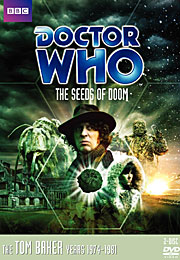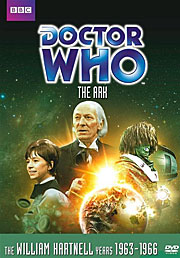Jackie Lane
- Sci-Fi
- 1976
- Buy the DVD
Reviewed by Ross Ruediger
()
his month’s “Doctor Who” DVD offerings, from a storytelling standpoint, have virtually nothing in common. One is a contemporary earthbound tale about an invader from space, while the other takes place far in the future, on a ship taking a vast voyage across the stars. One is a nice looking color production from the 70s, and the other is a creaky black and white yarn from the 60s. One of them is very, very good, and the other is, well, not. Aside from being “Doctor Who,” the two do have one other thing in common, and that’s that their titles are similar to some other “Who” stories, both of which have been previously released on DVD. Seven years before Tom Baker battled the Krynoid in “The Seeds of Doom,” Patrick Troughton squared off against the Ice Warriors in “The Seeds of Death,” and nine years after William Hartnell defeated the Monoids in “The Ark,” Tom Baker fought the Wirrn on a different ark (albeit one on a similar journey) in “The Ark in Space.” Hopefully nobody will get either of those arks confused with “Arc of Infinity,” but it is a possibility. If you’re confused, I apologize, because that wasn’t the intention.
Having previously praised two other stories (“Planet of Evil” and “The Brain of Morbius”) from Season Thirteen, it’s nice to have the opportunity to gush about its season finale, “The Seeds of Doom.” Yet another entry from the superb Philip Hinchcliffe produced era, “Seeds” sees the Doctor (Tom Baker) and Sarah Jane Smith (Elisabeth Sladen) coming into contact with a nasty form of alien life called the Krynoid. As the Doctor so succinctly puts it, “On most planets, the animals eat the vegetation. On planets where the Krynoid gets established, the vegetation eats the animals.”
The six-parter kicks off at a research base in Antarctica, where some scientists discover a pod buried beneath the frozen wasteland. They alert the World Ecology Bureau, which sends the Doctor and Sarah Jane to investigate. But there’s a traitor at the Bureau, and word of the pod’s existence makes its way to millionaire plant enthusiast and all-around madman Harrison Chase (Tony Beckley), who sends hired thug Scorby (John Challis) and botanist Keeler (Mark Jones) to the base to retrieve it. In the midst of all this, the pod opens up, attaches itself to one of the scientists, and a horrific transformation begins. As the Krynoid grows in strength and size, a hunch of the Doctor’s proves correct – there was a second pod buried near the first. While the Krynoid stalks the base, Scorby and Keeler get hold of the second pod and head back to England, with the Doctor and Sarah Jane not far behind.
The remainder of the story mostly takes place at Chase’s elaborate estate, as the Doctor and Sarah Jane play cat and mouse with him and Scorby, all while the second pod goes through the same process as the first, only this time Keeler ends up the unwilling host. Chase is obsessed with plants, and believes they should be the true rulers of the planet, and with the rapidly-growing Krynoid he now has the power to achieve his goals.
The first two episodes are highly reminiscent of “The Thing from Another World,” and there’s even the obvious “Day of the Triffids” comparison (although writer Robert Banks Stewart denies any such influence). What “The Seeds of Doom” really comes across as, though, is a modestly mounted Roger Moore-era James Bond adventure, replete with an insane villain wearing a nicely tailored suit and black gloves, his determined thug, nameless hired goons, a double-crossing bureaucrat, an eccentric artist, numerous occasions of heroes left to die only for them to escape after the villains leave the room, and a fair amount of uncharacteristic violence from the Fourth Doctor (punching, neck-cracking, and in one scene he even wields a gun). Baker’s Doctor has been physically violent in some other stories (“The Masque of Mandragora” and “The Deadly Assassin” are two such examples), but I don’t think he was ever as brutal as is he is here. It isn’t a slight against “Seeds,” but there are times when it feels strangely un-“Doctor Who”-like.
Baker and Sladen are very much on, with Sarah in particular getting some choice bits, including a couple of nicely impassioned speeches. But the supporting cast is equally fine across the board, and although Beckley scores big as the maniacal Chase, it’s really John Challis as Scorby who rises to the occasion, turning in an exceptional performance as the perpetually put out and pissed off thug, who may (or may not) be more complex than we give him credit for.
Another aspect that sets “Seeds” apart from much of its era is that the whole thing, despite having many, many exterior scenes, is all shot on videotape. As devoted fans have no doubt noticed, most 70s “Who” shifts back and forth between videotaped interiors and filmed exteriors, but that wasn’t the case here, and it’s mildly off-putting when you’re used to the show being presented the other way. Oh, the oddball things a fan can get used to! This was also the final UNIT story of the 70s (they wouldn’t be seen again until 1989’s “Battlefield”), and even though the team doesn’t look much like it did in its heyday (no Brigadier, no Sgt. Benton, and no Capt. Yates), it’s nice to see them get one big triumphant sendoff as they aid in the destruction of the Krynoid, which by the end of the story dwarfs Chase’s mansion.
After imbibing in the greatness of “The Seeds of Doom,” “The Ark” can’t help but pale in comparison, although it doesn’t necessarily take a great installment like “Seeds” to expose its weaknesses. The TARDIS materializes in what the crew believes to be a jungle, but turns out to be a vast spaceship carrying the remainder of mankind, as well as their servants, the Monoids, to a new home which is 700 years away. Unfortunately, the Doctor’s (William Hartnell) new companion Dodo (Jackie Lane) has a cold, which quickly spreads amongst the ship’s populace, and they must make things right, which they do by the end of the second episode, and then the crew are on their way. The ship immediately jumps into the future and rematerializes back onboard the ark near the end of the journey, only now, without explanation, the Monoids are in charge and the humans are the slaves. Time to make things right again.
“The Ark” has some undeniably great ideas, but somehow nobody ever seems to make very good use of them, as this thing is mighty snooze-inducing, and matters aren’t helped by the cardboard supporting cast or by the Monoids, who are effective for about the first two minutes they’re onscreen, but lose any elements of interest shortly thereafter. Yet there are “Who” stories that have succeeded on less, and I think what may be the real culprit here is that the combination of the First Doctor, Steven Taylor (Peter Purves) and Dodo Chaplet makes for perhaps the least engaging TARDIS crew in the history of the series, and since this story relies on the crew’s reactions to the various predicaments to make it interesting, it’s a losing situation. If you want to see an ark story, and haven’t seen Baker’s “The Ark in Space,” try that one on for size instead.
Special Features: “The Seeds of Doom” sports a revolving commentary track featuring Baker, Challis, Kenneth Gilbert (Dunbar), Michael McStay (Moberley), producer Philip Hinchcliffe, writer Robert Banks Stewart, designer Roger Murray-Leach, and Joggs Camfield, who is the son of the director, the late Douglas Camfield. There’s a 37-minute making-of called “Podshock,” a piece on Geoffrey Burgon’s musical score called “Playing in the Green Cathedral,” a “Now and Then” featurette on the locations, and a piece called “So What Do You Do Exactly?,” which features Graeme Harper discussing the roles of production assistant and production unit manager – two positions he held on “Who” before moving up to director. There’s also what I believe is the final installment of “Stripped for Action,” which covers the Fourth Doctor’s era and is just as much fun as all the previous entries. Now that every comics era from the classic series has been addressed, it’ll be great fun one day to sit down and watch this entire series back to back from the beginning. There’s also the usual photo gallery, PDF materials, isolated music score, production notes subtitle option, and some brief trailers and continuity bits, as well as a couple Easter Eggs and a coming soon trailer for “Meglos,” which actually came out back in January.
“The Ark” has a much simpler commentary, with only Peter Purves and director Michael Imison, moderated by Toby Hadoke. “The Ark” was Imison’s only contribution to “Who,” and, at least according to IMDb, was the last piece of TV he ever directed! “All’s Wells That Ends Wells” explores H.G. Wells’ influence on “Who” over the years. “One Hit Wonder” talks about monsters like the Monoids who were only seen once and were never heard from again. “Riverside Story” has Purves visiting Riverside Studios in Hammersmith, where various “Who” stories were recorded in the 60s. There’s also a photo gallery, production notes subtitle option, PDF materials, and a coming soon trailer for “Kinda” and “Snakedance,” both of which will be out in April.
You can follow us on Twitter and Facebook for content updates. Also, sign up for our email list for weekly updates and check us out on Google+ as well.














